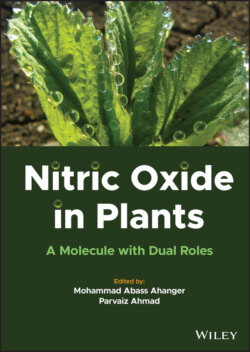Читать книгу Nitric Oxide in Plants - Группа авторов - Страница 14
1.4 Nitric Oxide’s Role in Abiotic Stress
ОглавлениеExisting climatic aberrations cause plants to be exposed to a variety of abiotic stresses such as drought, temperature increases, salinity, and oxidative damage. Because plants are sessile, they must deal with changing environmental conditions throughout their lives. Though plants develop various strategies to cope with adverse conditions, plant scientists and researchers are discovering new methods to learn about plants in stressful environments. In the presence of salt, substantial metals, drought, and oxidative stress, NO plays a critical role in abiotic stress management (Zhao et al. 2001, 2004; Uhida et al. 2002; Kopyra and Gwóźdź 2003). Abiotic stressors are a key stumbling block to agricultural growth while also jeopardizing food security (Figure 1.3). They also jointly influence the metabolism of plants and the defense of inhibitors. Recent NO studies show that they play a serious role in plant growth and mitigate environmental stress (Aroca et al. 2015; Corpas et al. 2019). Drought tolerance of cut leaves and seedlings of wheat was improved by exogenous NO application (Garcia-Mata et al. 2001). NO also mediates drought tolerance by the activation of numerous enzymes and plant metabolism inhibitors (Filippou et al. 2014; Shi et al. 2014). In many species, NO mediates stomatal rotation and defense methods in water stress (Greco et al. 2012; Garcia-Mata and Lamattina 2013; Chen et al. 2016). ROS and NO work synergistically to address the stress in water that causes ABA synthesis in wheat roots (Zhao et al. 2001). As proof of this, ABA accumulation under stress was prevented by the administration of ROS scavengers. The accumulation of NO tested jointly is needed in broad bean throughout ABA-induced stomata closure (Garcia-Mata and Lamattina 2002). Heat treatment of alfalfa cells, for example, has led to an increase in NO synthesis, while the application of exogenous NO improved cold tolerance in tomato, wheat, and maize (Neill et al. 2003). The observed effects were most likely associated with NO’s antioxidative action, which amplifies the negative effects caused by the intensification of peroxidative metabolism in high temperatures (Neill et al. 2002).
Figure 1.3 Schematic illustration of NO signaling in abiotic stress.
Mackerness et al. (2001) demonstrated the involvement of NO in plant response to UV-B radiation, demonstrating poststress induction of chalcone synthase expression, a rise in NOS-type protein activity, and an increase in NO levels. According to the findings of Shi et al. (2005), NO positively shields plants against UV-B radiation, most likely through increased activity of the antioxidative system. NO-donor treatment of potato tubers prior to UV-B irradiation resulted in the development of approximately 50% more healthy leaves than plants not subjected to NO treatment (Neill et al. 2003). Exogenous NO has been shown to reduce the deleterious effects of heavy metals, ethylene, and herbicides on plants in response to alternative abiotic stresses (Kopyra and Gwóźdź 2003). The authors explained the protective effect as a result of NO-donor treatment of plant materials by the effect of NO on the elevation of activity of antioxidative enzymes, particularly SOD (Kopyra and Gwóźdź 2003).
According to the cited authors, such a chain of events could effectively reduce the amount of ROS produced during stress, thereby limiting oxidative stress in plant cells. Similarly to salinity stress, NO-donor treatment of rice seedlings resulted in loss minimization (Uhida et al. 2002). When NO was used, plant growth was increased, along with the maintenance of acceptable photosystem II activity, an increase in antioxidative protein activity, and thus the expression of specific salinity stress resistance genes. On the other hand, prolonged stress situations may result in the production of NO and NO-derived products, resulting in specific responses, referred to as nitrosative stress. Valderrama et al. (2007) found that salinity stress elicited the assembly of RNS, i.e. NO, GSNO, and RSNO, as well as an increase in tyrosine-nitrated proteins, which are sensitive markers of nitrosative stress, in olive leaves. Furthermore, they demonstrated that vascular tissues may play an important role in the distribution of NO-derived forms during nitrosative stress and in signaling processes. Tissue damage, which is usually due to a microorganism invading a cell, frequently results in NO production and H2O2 accumulation (Delledonne et al. 1998). According to Orozco-Cardenas and Ryan (2002), injury does not induce NO synthesis; however, the use of exogenous NO inhibits the method of NO generation and expression of wound-inducing genes.
It is important to note that many types of abiotic stress (cold and heat stress, salt and drought stress) increase polyamine (PA) synthesis (Bouchereau et al. 1999). Tun et al. (2006) discovered that PAs significantly increase NO generation. Work on Arabidopsis seedlings confirms that NO acts as a channel between PA-mediated stress responses and an alternative stress mediator, with NO as a stepping stone.
By scavenging ROS, NO plays a significant role in inhibitor defense against many abiotic stresses. Salinity stress has a negative impact on plant morphological traits and diffusion balance. Additionally, it promotes membrane disintegration, DNA damage, particle discharge, and death. NO has been shown to have a potential effect on diffusion stress tolerance as well as increased spermatophyte growth in rice, lupin, and cucumber when subjected to salt stress (Uchida et al. 2002; Kopyra and Gwóźdź 2003; Fan et al. 2007, 2013; Barakat et al. 2012). Similar evidence has been reported demonstrating the potential effect of NO in mitigating salinity stress in alfalfa, barley, jatropha, chickpea, and sunflower (Nabi et al. 2019). In Oryza sativa, a NO donor SNP inhibited accumulation, reduced ROS generation, and improved root growth (Kushwaha et al. 2019). In various plant species, the potential role of gas in mitigating serious metal toxicity has been investigated (Ahmad et al. 2018; Yuanjie et al. 2019; Bhuyan et al. 2020; Wei et al. 2020; Khator et al. 2021). As a result, it is clear that NO gas could be a potential mitigating agent for abiotic stresses.
